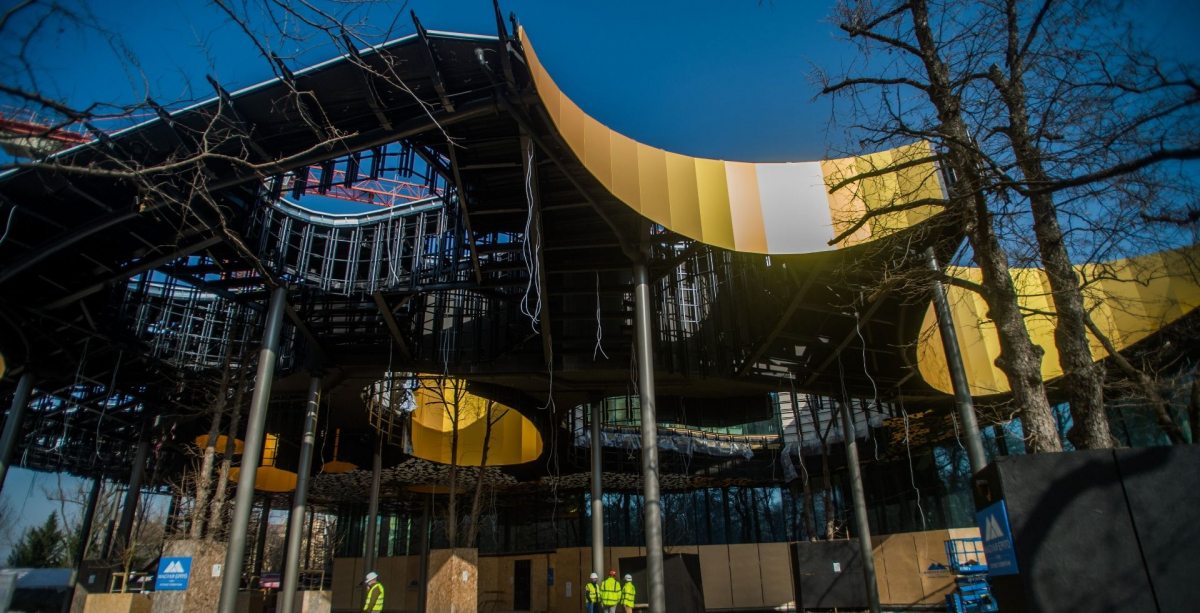The acoustic testing of the House of Hungarian Music was successfully carried out by the world-famous Japanese Nagata Acoustics. The music initiation institution being built as part of the Liget Budapest project will be completed by the end of the year and will welcome visitors from the beginning of 2022.
In the past few days, we heard music for the first time in the three-hundred-seat large hall and one-hundred-seat small hall of the Hungarian Music House, and the result exceeded all our expectations, the managing director of the Hungarian Music House told MTI.
András Batta added: the acoustic testing was entrusted to the Nagata Acoustics office, which, in addition to many large concert halls in Japan, also worked on the acoustic setup of, for example, the Walt Disney Concert Hall in Los Angeles, the Elbphilharmonie in Hamburg, the concert hall of the Mariinsky Theater in St. Petersburg, and the Philharmonie de Paris.
The acoustic testing of the Magyar Zene Háza was also particularly exciting because the building is largely made of glass, the facade glass wall consists of 94 individually manufactured, undivided and thermally insulated panels, which in some sections of the building are close to 12 meters high. However, glass is not very good for acoustics, because the sound "bounces back" from these flat surfaces, and this is usually not good for the sound, he noted.
According to András Batta, however, it turned out that the world-renowned Japanese architect Sú Fujimoto, who dreamed up the building, had already taken acoustic issues into account during the building's design, so the sound of the hall exceeded expectations.
The staff of Nagata Acoustics carried out measurements for a week: the rooms were first tested without sound, with acoustic instruments - a solo flute and a string quartet, then with folk instruments, and finally with sound, the director reported.
It is interesting that the acoustic sound quality is the same at any point in the hall, the musicians could hear themselves and each other well on the stage, which is not a matter of course in every concert hall - he noted, adding: since the wall of the small hall was supplemented with wooden elements that aid good sound, so there they expected good acoustics.
András Batta said: measurements were also carried out in silence to test how well the sounds of the environment filter in and how much the building's machinery can be heard, but the building passed these tests as well, the Japanese specialists only suggested a few minor corrections.
Thus, it can be safely stated that the House of Hungarian Music can host classical, jazz, world, folk and light music concerts, and in addition, an open-air stage for 200 people has been created in the part covered by the roof, he said.
András Batta emphasized, however, that the House of Hungarian Music will function as a true music initiation institution, which includes, in addition to concerts and events, unusual music education activities and permanent and temporary exhibitions.
The exhibition space will be built below ground level, with a unique sound dome, which cannot be found anywhere else in the world on a permanent basis - he pointed out, adding: the projectors, the 360-degree projection screen and the speakers have already been installed here for the most part.
According to the director's report, the permanent exhibition will offer a music history experience walk in a special, interactive installation. For this purpose, a one thousand square meter space is built thematically, and the content elements of the exhibition are also being prepared in parallel: the implementation of hundreds of musical parts, film insertions, video mapping, animation and other multimedia content is underway.
We are sticking to the schedule, so the test operation of the house can begin within a few weeks, and the construction will be completed this year, and the House of Hungarian Music will open its doors to the public at the beginning of next year - announced András Batta.
Even after that, new things await the visitors - he noted: the first temporary exhibition is planned for a little later, since the public will still be able to meet enough new things and experiences when the house opens. After the permanent exhibition, the creative sound space that functions as a "palace of musical wonders" will be open to the public, and from spring, children will also be able to take possession of the outdoor musical playground next to the house. So: City park atmosphere, in the grove of music - added András Batta.
Source: MTI
Featured image: PESTBUDA













